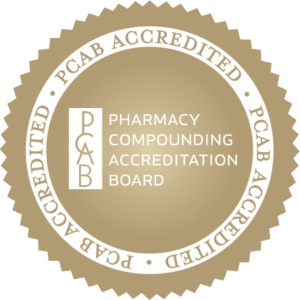Insight Into Gut Health and Weight Loss
The human gut microbiome is a complex and dynamic ecosystem within the gastrointestinal tract. The bacteria, fungi, and other microbes that comprise it play a crucial role in overall health, including metabolism, immune function, and weight regulation. This diverse microbial community helps break down complex nutrients, produces essential vitamins, and regulates inflammation. In this blog, we’ll explore the link between gut health and weight loss management, clinical support, and more.
Recent research underscores the connection between gut health and weight loss. One of the pivotal elements of this relationship is the impact of the microbiome on the production of GLP-1 (glucagon-like peptide-1), a hormone that is crucial for regulating blood sugar levels and suppressing appetite. GLP-1 receptor agonists, such as semaglutide and tirzepatide, which are used in weight loss therapies, mimic this naturally occurring hormone.
GLP-1 not only facilitates insulin secretion and slows gastric emptying but also promotes a feeling of fullness after eating, which is essential for weight control. A well-balanced and diverse gut microbiome can enhance the natural production of GLP-1, aiding in better blood sugar regulation and appetite suppression. Conversely, an imbalance in the gut microbiota, known as dysbiosis, can lead to decreased GLP-1 secretion, potentially causing increased appetite, insulin resistance, and subsequent weight gain.
Dietary Influences on the Microbiome and GLP-1

The microbiome’s health is significantly influenced by diet, particularly through the intake of various types of dietary fibers that serve as prebiotics. These fibers feed beneficial gut bacteria, which in turn produce short-chain fatty acids (SCFAs) that nourish the gut lining and support metabolic health. There are two primary types of fiber that impact the microbiome:
- Soluble Fiber: Found in foods like oats, beans, nuts, and fruits, soluble fiber dissolves in water and is fermented by gut bacteria. This fermentation process leads to the production of SCFAs, which have been shown to enhance the production of GLP-1.
- Insoluble Fiber: Commonly found in whole grains and vegetables, insoluble fiber adds bulk to the stool and helps with digestion. While less impactful on the microbiome than soluble fiber, it still plays a vital role in maintaining overall gut health.
Incorporating a balanced diet rich in both types of fiber can significantly contribute to the maintenance of a healthy microbiome, thereby supporting the natural production of GLP-1 and enhancing weight management efforts.
Clinical Insights and Practical Applications
Clinical studies have demonstrated that interventions aimed at modulating the gut microbiome may have favorable outcomes on weight management. For example, enhancing GLP-1 production through dietary changes has shown potential in reducing the dependence on pharmacological interventions. Healthcare providers, especially those focusing on metabolic health and obesity, are increasingly recognizing the importance of gut health in their therapeutic approaches. By advising patients on diets rich in diverse fibers and potentially supplementing with probiotics, clinicians can help enhance patients’ natural GLP-1 production, thus supporting sustainable weight loss and overall metabolic health.
As research continues to unravel the complex interactions between diet, the microbiome, and weight management, it becomes clear that a multifaceted approach involving dietary management, understanding of gut health, and judicious use of medications like GLP-1 receptor agonists may offer a comprehensive strategy for tackling obesity. Embracing these insights not only aids in weight reduction but also enhances overall well-being and disease prevention.
By integrating dietary strategies that promote a healthy microbiome with targeted pharmacological therapies, individuals can achieve more sustainable outcomes in weight management.
Guidance from HDRx on Your Gut Health and Weight Loss Journey
At Health Dimensions Clinical Pharmacy (HDRx), our team of experts provides comprehensive support to individuals navigating the challenges of weight management. Our pharmacists, well-versed in the latest advancements in metabolic health, offer personalized consultations to understand each patient’s unique needs.

Personalized Consultation and Support
Understanding that weight loss is a personal journey, HDRx offers one-on-one consultations. During these sessions, our pharmacists provide insights into how compounded medications like GLP-1 receptor agonists — such as semaglutide and tirzepatide — may be integrated into a broader health plan. These consultations are designed to tailor patients’ therapies to align with individual health goals and lifestyle preferences.
Compounded GLP-1 Medications
When patients aren’t getting the results they want in their weight loss journey from diet and lifestyle efforts, HDRx’s state-of-the-art compounding facilities prepare GLP-1 medications semaglutide and tirzepatide. Our pharmacists work with Michigan practitioners to help their patients hit their weight loss goals.
Nutritional Guidance and Supplements
Alongside pharmacological approaches, HDRx emphasizes the importance of nutrition in managing weight. Our experts guide patients through the complex landscape of dietary choices and nutritional supplements that may support a healthy metabolism and enhance the results of GLP-1 medications. By focusing on gut health and its role in weight management, we help patients make informed decisions that sustain potential long-term health benefits.
Trust and Quality Assurance
HDRx is proud of its PCAB (Pharmacy Compounding Accreditation Board) accreditation, a testament to our commitment to maintaining the highest standards of quality and safety in medication compounding. This accreditation reassures our patients and healthcare partners that HDRx adheres to rigorous protocols, ensuring that every compounded medication is safe and effective.
By choosing HDRx for your weight management needs, you’re partnering with a trusted team dedicated to providing high-quality, personalized care that supports your health and well-being. Whether you’re exploring GLP-1 medications for the first time or seeking a more integrated approach to managing your weight, HDRx is here to guide you every step of the way.
References
Brubaker, P. L. (2018). Linking the gut microbiome to metabolism through endocrine hormones. Endocrinology, 159(8), 2978-2979. Link
Everard, A., & Cani, P. D. (2014). Gut microbiota and GLP-1. Reviews in endocrine and metabolic disorders, 15, 189-196. Link
Gowd, V., Xie, L., Zheng, X., & Chen, W. (2019). Dietary fibers as emerging nutritional factors against diabetes: focus on the involvement of gut microbiota. Critical reviews in biotechnology, 39(4), 524-540. Link
Lin, T. (2024). The Effects of Dietary Fiber on Metabolic Health and Gut Microbiota. MedScien, 1(7). Link
Martin, A. M., Sun, E. W., Rogers, G. B., & Keating, D. J. (2019). The influence of the gut microbiome on host metabolism through the regulation of gut hormone release. Frontiers in physiology, 10, 428. Link
Shallangwa, S. M., Ross, A. W., Walker, A. W., & Morgan, P. J. (2024). Resident gut microbiota community determines the efficacy of soluble fiber in reducing adiposity. Frontiers in Microbiology, 15, 1392016. Link
Tsai, C. Y., Lu, H. C., Chou, Y. H., Liu, P. Y., Chen, H. Y., Huang, M. C., … & Tsai, C. N. (2022). Gut microbial signatures for glycemic responses of GLP-1 receptor agonists in type 2 diabetic patients: a pilot study. Frontiers in Endocrinology, 12, 814770. Link
Utzschneider, K. M., Kratz, M., Damman, C. J., & Hullarg, M. (2016). Mechanisms linking the gut microbiome and glucose metabolism. The Journal of Clinical Endocrinology & Metabolism, 101(4), 1445-1454. Link
Zeng, Y., Wu, Y., Zhang, Q., & Xiao, X. (2024). Crosstalk between glucagon-like peptide 1 and gut microbiota in metabolic diseases. Mbio, 15(1), e02032-23. Link











